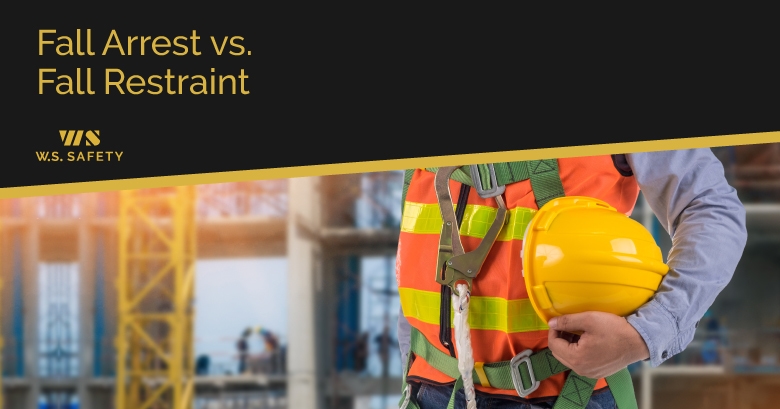What is the main difference between fall arrest vs. fall restraint systems?
Fall arrest equipment is designed to stop a fall that has already happened. It is activated after a worker slips, “arresting” their fall in mid-air.
On the other hand, fall restraint equipment is designed to prevent a fall in the first place.
In this article, we will explore applications and considerations specific to both types of fall protection systems.
Fall Arrest vs Fall Restraint According to OSHA
The Occupational Safety and Health Administration in the US details some of the key differences between fall arrest and fall restraint equipment.
Personal fall arrest systems (PFAS) will not be used in situations where there is not enough distance from the top level to lower level for the arrest mechanism to prevent the worker from touching the lower level.
Determining whether or not a PFAS is an appropriate fall protection measure requires a number of careful calculations.
The engineer in charge of fall protection must determine:
- The total fall clearance, which is the amount of distance needed to ensure a worker does not come into contact with the bottom level
- The free fall distance, which is the distance the falling worker will travel before the fall arrest system begins to stop the fall
- Deceleration distance, which describes the stretch of the lanyard as the deceleration device is deployed
- The height of the worker
- The amount to which the D-ring on the worker’s harness shifts from its location between the worker’s shoulder blades
- The length of the lanyard and the height of its anchor point. This becomes complicated if the lanyard is attached to a horizontal lifeline as the line will stretch during a fall event.
In addition to these calculations, a safety factor of 2 feet is added onto the total.
If the sum total of these variables is more than the total fall clearance, a fall restraint system will be employed instead.
Fall Restraint System Components
Fall restraints fall under the category of fall prevention.
Covers for holes and guardrails are other forms of fall prevention equipment.
A fall restraint system will prevent the worker from being exposed to a fall hazard by restricting the worker’s travel along an elevated surface.
Typically, a horizontal safety line will be established across two anchor points. This horizontal lifeline will then be connected to the worker by a fall restraint lanyard that is attached to the worker’s harness on one end and an o-ring that runs along the safety line on the other.
In order for a fall restraint system to be safe, it needs to calculate the force the system is required to withstand to keep a worker safe from reaching the fall hazard. This force can arise from leaning away from the safety line, walking away from it or even sliding or slipping.
Then, that figure is doubled. The resulting total is the amount of force the fall restraint system needs to withstand at minimum in order to be considered secure.
With a proper fall restraint system in place, workers can have freedom of movement to do their job while being safe from falls.
What About Work Positioning Systems?
Work positioning equipment, also known as fall positioning systems, are under the category of fall prevention. But they are not quite the same as a fall restraint system.
A work positioning system is designed for vertical surfaces like walls or hydro poles.
There are different variations available, but a work positioning lanyard will often consist of an adjustment device which is connected to the worker’s harness at one hip.
A length of rope is fed through the adjustment device, typically between 2 and 5 meters in length. It can be used to wrap around an anchor point before the connector at the opposite end of the lanyard is attached to the worker’s opposite hip.
The worker can then lean back and adjust the amount of slack needed to do their work with the adjuster.
As they work up or down a vertical surface, they can re-establish new anchor points as they go. It allows them to remain tethered to a structure in one place for extended periods of time with their hands free to perform their work.
A work positioning system will ideally be integrated into other fall arrest measures. Having other fall protections in place as backup is recommended.
Conclusion: Fall Restraint & Fall Arrest Considerations
The suitability of a fall restraint or fall arrest system depends on the nature of the fall hazards at a worksite.
Anchor points for fall arrest systems need to be planned carefully. An important consideration is the strength of the structure to which it is being attached. If it is attached to an unfinished wall, for example, the force of a fall event may take the wall down with the worker.
Another consideration with PFSAs is swing fall hazards. If the anchor is not directly overhead, the worker may become injured by swinging into surfaces or objects.
The dangers of a swing fall hazard have to be assessed. If necessary, the anchor point will need to be installed above the work area.
Fall arrest training is a must for anyone working in these environments.
As far as fall restraint anchor point requirements, the points must be established so as to withstand double the amount of force that would allow a worker to reach a fall hazard.
These can be permanent or temporary, as long as they are properly secured.
As with all fall protection measures, a great deal of planning and pre-engineering is required to determine between fall arrest vs. fall restraint systems.


